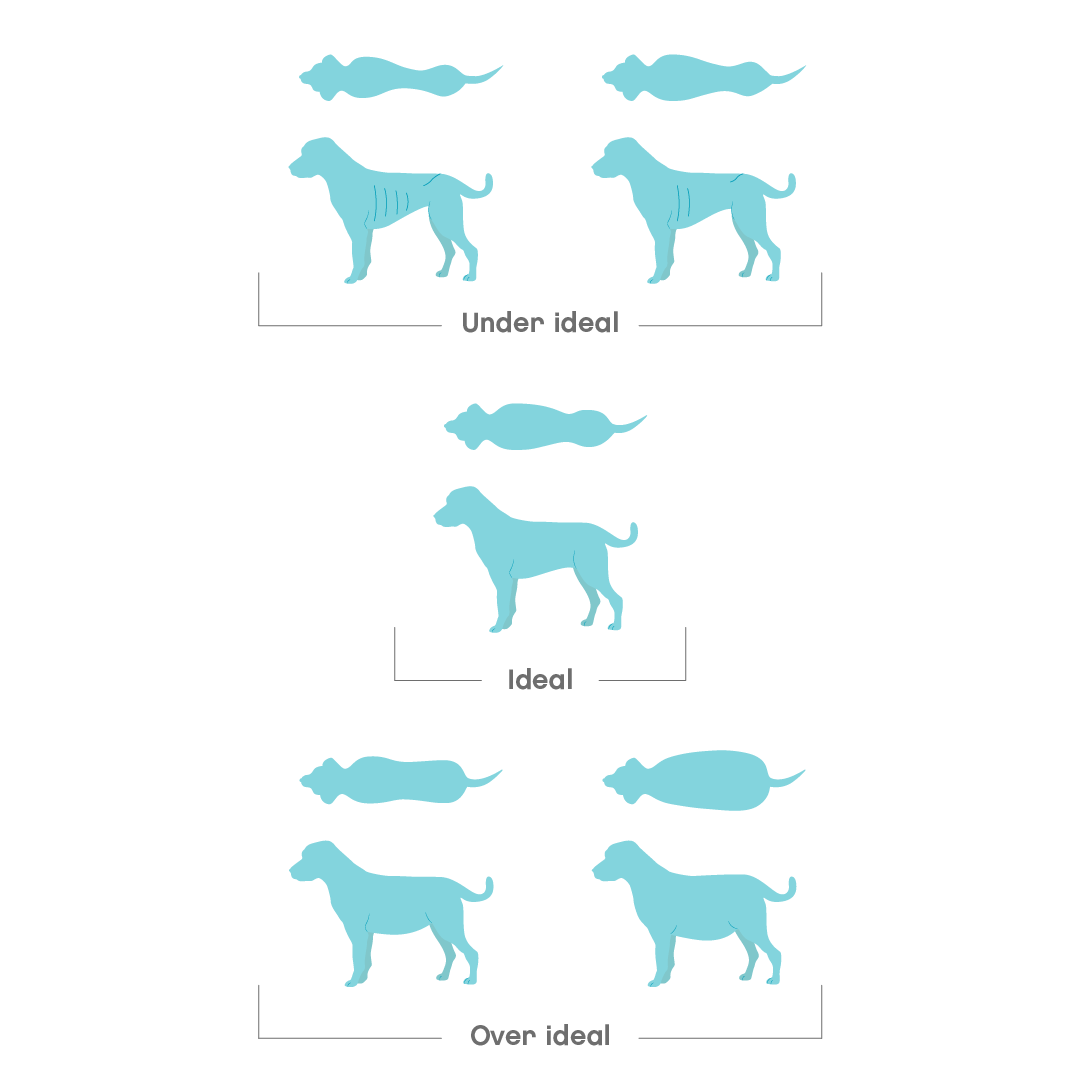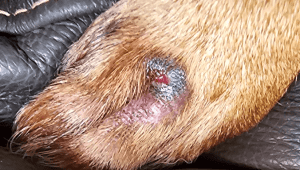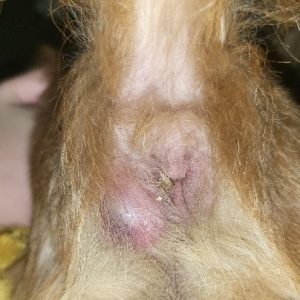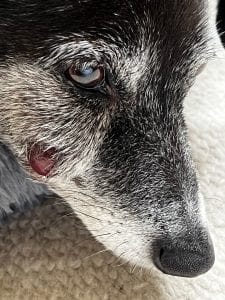An abscess is an enclosed area of pus caused by a bacterial infection. Abscesses can develop in different parts of the body and affect dogs of any age.
There are many different causes of abscesses. The most common types of abscesses are easy and quick to treat. There are less common types (mostly internal) that can be life-threatening if not treated promptly. Abscesses are painful for dogs, so we always recommend speaking to a veterinarian to discuss the best treatment for your dog.
What to do
What to do if your dog has an abscess
If you suspect your dog has an abscess, we recommend speaking to a vet as soon as possible. Abscesses are painful and usually require specific medication.
While waiting for an appointment, you can
- Use a warm compress on the area to help relieve discomfort
- Clean any discharge with cooled, boiled water to avoid crust build-up
- Use a buster collar or pet medical suit to prevent self-trauma to the affected area
- Let your pet rest in a quiet and comfortable area
- Make sure they are eating and drinking
Be careful if you try to clean the area or apply a warm compress. Dogs may become aggressive when they are in pain. If they show any sign of this, then it is best to leave the area alone and get a vet appointment as soon as possible.
Abscesses can worsen if not treated promptly. Joii Vets are available 24 hours a day for advice. Call us now if you have any concerns.
Causes
Common causes of abscesses in dogs
- Skin abscess: due to foreign material, such as grass seeds or sticks, or due to bite Wounds from other animals
- Tooth root (dental) abscess
- Anal gland abscess
- Tumours leading to secondary infection
- Abscess of the prostate gland
When to worry
When you should be worried about abscesses in dogs
Seek help from a vet if
- Your dog is in Pain
- Your dog has not been eating or drinking for more than 24 hours
- Your dog is passing blood in their urine
Call us and speak to one of our Joii Vets
- For advice about how to keep your dog’s mouth healthy and prevent Bad breath
- For advice about how to help prevent anal gland disease
- If you have any questions about neutering your dog
- If your dog has been bitten by another animal
Prevention
Tips on how to prevent your dog from getting abscesses
Unfortunately, not all abscesses are preventable; however, there are measures that dog owners can take to reduce the chances of certain types:
- Speak to a vet as soon as possible if your dog has been bitten or scratched by another animal, thorough cleaning as early as possible is important
- Avoid areas where there are grass seeds during the summer months
- Check your dog over after walks and remove any grass seeds or foreign objects from their coat. Make sure to check in between their toes, as this is a common area where they get stuck.
- Avoid playing with sticks
- Get your dog’s teeth checked at least every 6 months with your vet
- Keep your dog’s teeth clean by brushing them with a dog friendly toothpaste and using a special dental food
- If your dog has anal gland issues, use fibre supplements and get them checked or emptied when needed
- Getting your male dog neutered can prevent prostate abscesses
- Keep your dog in healthy body condition
Body Condition Score (BCS) is a scale that gives a practical evaluation of the fat coverage of your dogs body. By checking how easy or not it is to feel certain bony areas of the body, a score is then produced. There are several scales, from 1 to 5 or 1 to 9. The ideal body condition lies in the middle, so either 3/5 or 5/9. The body areas normally checked for fat coverage are: 1. ribs and spine 2. hips and shoulders 3. waist Here are a few tips on how to do it. With your pet in a standing position:
Body Condition Scoring (BCS) in dogs

Speak to our Joii team if you have any questions about preventing abscesses in dogs.
Diagnosis
How to know if your dog has an abscess
The symptoms of any abscess depend on where it is located
- The most common signs are heat, swelling, and pain in the area (unless it is inside a body cavity)
- Your dog may try to constantly lick or bite the area where the abscess is
- The abscess may rupture and produce a smelly discharge of pus and blood.
- Dogs with an abscess may also have a fever, which can cause a reduced appetite and lethargy
- Limping is a common sign if the abscess involves a limb

- Abscess due to a grass seed in the paw
Anal gland abscess signs
- Pain and swelling around the anus
- Scooting and rubbing their bottom on the ground
- Excessive biting and hair loss around the bottom or back legs
- Straining to pass stools

- anal gland abscess
Tooth root abscess signs
- Bad breath and chewing on one side
- Drooling
- Swelling on the face, usually below the eye
- Pawing at their face or rubbing it on the floor

- Dental abscesses often appear below the eye
Prostate abscess signs
- Straining to pass stools and urine
- Blood in the urine
- Tummy pain and reluctance to walk
Home treatment
How to treat abscesses in dogs at home
Unfortunately, most abscesses will require a physical exam and prescription medication for treatment.
Once your dog is on the appropriate medication, you can
- Make sure to give the medication as often as advised; do not skip doses or finish the course early
- Clean the open abscess with saline if your vet recommends it
- Give your dog a quiet and comfortable place to rest in the house. Avoiding exercise during treatment is usually advised, especially if surgery is involved
- Ensure your dog is eating well: soft food or a highly palatable diet may be needed for certain conditions
- Monitor your dog closely: if the swelling or pus are not disappearing, then other medication may be needed
- Abscesses do not normally spread to other areas of the body or other pets
Vet treatment
Vet treatment for abscesses in dogs
Treatment of an abscess will depend on where it is located and the cause.
- Most abscesses will require antibiotics and anti-inflammatory pain relief medication
- Some will need to be lanced (cut-open) and flushed, including removal of any foreign material (bite abscesses and those with grass seeds or sticks)
- Others may require more specific surgery, such as tooth removal, tumour removal or castration
- Sedation or anaesthesia is needed for all of these procedures
After a full clinical exam (including a rectal exam to check the prostate), the following tests may be required
- Analysis of a sample of the discharge from the abscess
- Blood and urine tests to check for underlying disease
- Imaging: x-rays, ultrasound, CT or MRI, depending on where the abscess is located
Risk
Are some dogs at more risk of abscesses than others?
- Older, unneutered dogs are more at risk of prostate abscesses. This is a condition that does not affect female dogs.
- Older dogs, small breeds (such as Yorkshire terriers and Chihuahuas), short face dogs (such as Pugs and Bulldogs) and stick or stone chewers are at higher risk of dental disease and a tooth abscess
- Dogs with diarrhoea, allergies, poor diets and small breeds (such as Spaniels, Shih Tzus and Bichon Frises) are more likely to develop an anal gland abscess.
Other causes of abscesses in dogs
- Liver abscesses in dogs are rare. Usually caused by a bacterial infection in the blood. Symptoms include lethargy, fever, reduced appetite, and vomiting.
- Lung abscesses in dogs are very rare. They are usually caused by severe pneumonia, trauma, or an inhaled foreign object. Symptoms include reduced appetite, coughing, lethargy, and fever.
- Brain abscesses are rare in dogs. Causes include inner ear infections or trauma. Symptoms include fever, seizures, and behavioural changes.
- Post-surgical reactions are abscesses that form at the site of incision. Risks include longer operations, moist wounds (i.e. due to licking), and wounds that are not clipped and cleaned properly. Symptoms include pus, pain, and swelling.












